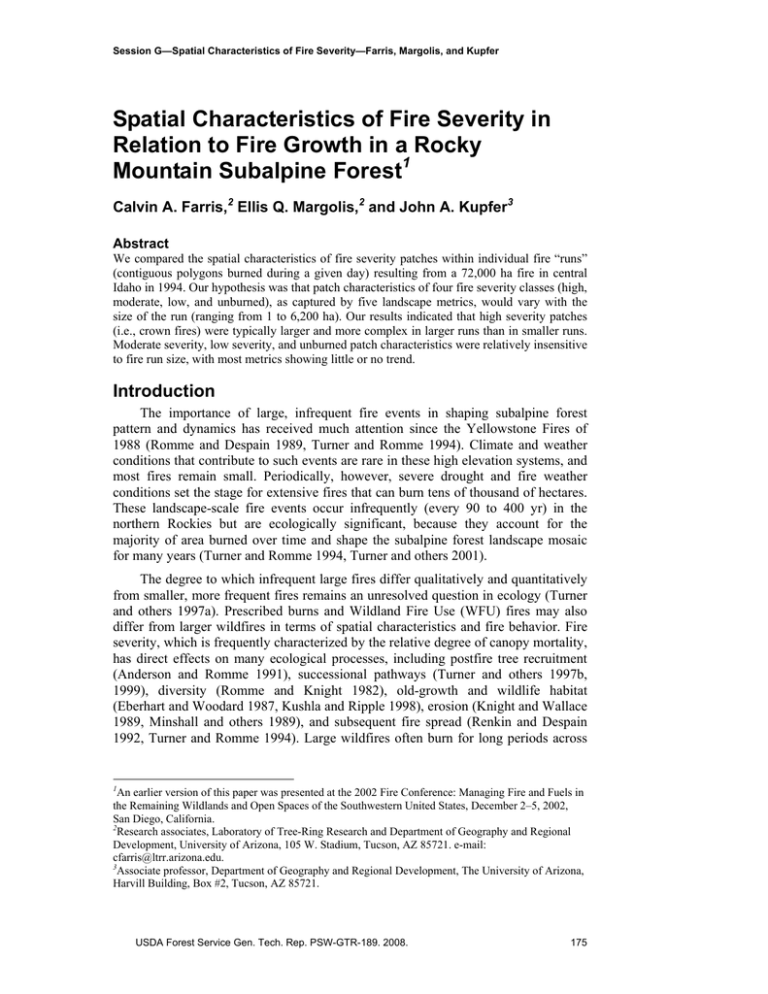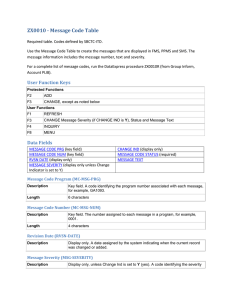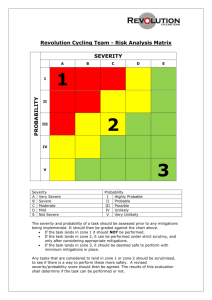Spatial Characteristics of Fire Severity in Mountain Subalpine Forest
advertisement

Session G—Spatial Characteristics of Fire Severity—Farris, Margolis, and Kupfer Spatial Characteristics of Fire Severity in Relation to Fire Growth in a Rocky Mountain Subalpine Forest1 Calvin A. Farris,2 Ellis Q. Margolis,2 and John A. Kupfer3 Abstract We compared the spatial characteristics of fire severity patches within individual fire “runs” (contiguous polygons burned during a given day) resulting from a 72,000 ha fire in central Idaho in 1994. Our hypothesis was that patch characteristics of four fire severity classes (high, moderate, low, and unburned), as captured by five landscape metrics, would vary with the size of the run (ranging from 1 to 6,200 ha). Our results indicated that high severity patches (i.e., crown fires) were typically larger and more complex in larger runs than in smaller runs. Moderate severity, low severity, and unburned patch characteristics were relatively insensitive to fire run size, with most metrics showing little or no trend. Introduction The importance of large, infrequent fire events in shaping subalpine forest pattern and dynamics has received much attention since the Yellowstone Fires of 1988 (Romme and Despain 1989, Turner and Romme 1994). Climate and weather conditions that contribute to such events are rare in these high elevation systems, and most fires remain small. Periodically, however, severe drought and fire weather conditions set the stage for extensive fires that can burn tens of thousand of hectares. These landscape-scale fire events occur infrequently (every 90 to 400 yr) in the northern Rockies but are ecologically significant, because they account for the majority of area burned over time and shape the subalpine forest landscape mosaic for many years (Turner and Romme 1994, Turner and others 2001). The degree to which infrequent large fires differ qualitatively and quantitatively from smaller, more frequent fires remains an unresolved question in ecology (Turner and others 1997a). Prescribed burns and Wildland Fire Use (WFU) fires may also differ from larger wildfires in terms of spatial characteristics and fire behavior. Fire severity, which is frequently characterized by the relative degree of canopy mortality, has direct effects on many ecological processes, including postfire tree recruitment (Anderson and Romme 1991), successional pathways (Turner and others 1997b, 1999), diversity (Romme and Knight 1982), old-growth and wildlife habitat (Eberhart and Woodard 1987, Kushla and Ripple 1998), erosion (Knight and Wallace 1989, Minshall and others 1989), and subsequent fire spread (Renkin and Despain 1992, Turner and Romme 1994). Large wildfires often burn for long periods across 1 An earlier version of this paper was presented at the 2002 Fire Conference: Managing Fire and Fuels in the Remaining Wildlands and Open Spaces of the Southwestern United States, December 2–5, 2002, San Diego, California. 2 Research associates, Laboratory of Tree-Ring Research and Department of Geography and Regional Development, University of Arizona, 105 W. Stadium, Tucson, AZ 85721. e-mail: cfarris@ltrr.arizona.edu. 3 Associate professor, Department of Geography and Regional Development, The University of Arizona, Harvill Building, Box #2, Tucson, AZ 85721. USDA Forest Service Gen. Tech. Rep. PSW-GTR-189. 2008. 175 Session G—Spatial Characteristics of Fire Severity—Farris, Margolis, and Kupfer extensive areas and encompass a wider range of weather conditions, topography, and vegetation variability than smaller fires. Remote sensing and GIS have been used widely to map fire growth and extent (see Miller and Yool 2002), but fewer studies have analyzed spatial patterns of fire characteristics such as fire severity (Turner and others 1994). However, the area burned on any given day is usually divided up into a large number of individual patches of varying size, because spread progresses from multiple fronts and/or becomes fragmented. This can confound calculations of patch characteristics, such as size and shape, and landscape pattern complexity. Our objective is to quantify and compare the spatial characteristics of fire severity patches using “fire runs” (individual, contiguous polygons burned during a given day) as the unit of analysis. We examine landscape metrics for different fire severity classes as a function of fire run size and speculate on the relative influence of large and small fires on the landscape mosaic. Methods Study Area The Corral-Blackwell Complex Fire burned approximately 72,000 ha in the Salmon River Mountains of central Idaho in 1994 (fig. 1). The fire burned from August 3 through October 6, when it was extinguished by precipitation. Much of the area burned resulted from few days with exceptional fire growth (fig. 2). Fire suppression focused primarily on structure protection and confinement and was minimal throughout the burn. Elevation within the fire perimeter ranged from 600 to 2,735 m, but more than 85 percent of the area burned was in subalpine forests above 1,850 m. Affected forests consisted primarily of mixed stands of lodgepole pine (Pinus contorta Doug. Ex Loud. var latifolia), Engelmann spruce (Picea engelmannii Parry ex Engelm.), and subalpine fir (Abies lasiocarpa [Hook.] Nutt.). Other species included Douglas-fir (Pseudotsuga menziesii var. glauca [Beissn.] Franco), grand fir (Abies grandis [Dougl.] Lindl.), and whitebark pine (Pinus albicaulis Engelm.). Corral-Blackwell Fire Perimeter Payette National Forest Boise I D A H O Figure 1—Location and perimeter of the Corral-Blackwell Fire. 176 USDA Forest Service Gen. Tech. Rep. PSW-GTR-189. 2008. Session G—Spatial Characteristics of Fire Severity—Farris, Margolis, and Kupfer Area Burned (ha) 10,000 8,000 6,000 4,000 2,000 0 8/3 8/10 8/17 8/24 8/31 9/7 9/14 9/21 9/28 10/5 Date Figure 2—Daily area burned in the Corral-Blackwell Fire. Fire Severity Mapping The relative degree of crown damage and canopy mortality caused by a fire is commonly referred to as fire severity. Immediately after a fire, crown damage is closely related to the behavior and intensity of the fire, but the degree of canopy mortality can change dramatically over time as burned trees eventually succumb to cambial or crown damage and changes in environmental conditions (Agee 1993, Ryan and Amman 1996). Thus, analyses of the postfire mosaic are dependent on the timing of fire severity mapping. Kafka and others (2001) distinguish between initial and longer-term damage by calling the former “fire impact” and the latter “fire severity.” While we focus explicitly on initial patch characteristics related to the behavior and intensity of the fire, we choose to utilize the more widely recognized term fire severity but acknowledge the important distinction between initial and eventual impacts of fire. For this research, we used a spatial database developed by the U.S. Forest Service after the Corral-Blackwell Fire (Boudreau and Maus 1996, Farris and others 1998, Greer 1994). Fire severity was mapped from Landsat Thematic Mapper Imagery acquired on October 8, 1994. An unsupervised classification was performed to delineate four classes of fire severity based on the relative amount of overstory crown damage (see Boudreau and others 1996, Farris and others 1998 for more detail): 1. High Severity–Complete canopy consumption (e.g., a “crown fire”). Duff layer usually consumed. 2. Moderate Severity–Needles scorched but not consumed on >50 percent of stand. Duff layer usually partially consumed. 3. Low Severity–Little discernable damage to the overstory foliage (<50 percent of stand). Duff consumption light or patchy. 4. Unburned–An unburned area within the fire perimeter. Imagery was flown within 1 week of active burning, therefore crown damage was primarily due to direct impact rather than longer-term mortality. Based on an assessment of 238 field plots established after the fire and aerial photo interpretation, the map accuracy ranged from 89 percent for the high severity class to a low of 71 percent for the low severity class. USDA Forest Service Gen. Tech. Rep. PSW-GTR-189. 2008. 177 Session G—Spatial Characteristics of Fire Severity—Farris, Margolis, and Kupfer Stratification of Fire Severity by “Run” Size Using daily fire progression maps created by the U.S. Forest Service with twicedaily infrared flights (Greer 1994), we identified individual runs using GIS (fig. 3a). Many runs were composed of patches of varying severity, including unburned areas. Fire severity information from the classified TM image was extracted for each run and compiled into a database for the calculation of landscape metrics (fig. 3b). All runs were assigned to one of fourteen rank run size classes based on the standard deviation from mean run size (table 1). This approach provided an even and representative gradient of run sizes, but the lack of replication of larger runs made rigorous statistical comparisons difficult. Table 1–Ranked run size classes based on standard deviations (STDV) from the mean, and the corresponding area and number of patches (n) within each class. The mean fire run size was 36 hectares. Rank run STDV Area size class from mean (ha) 1 -1a <36 2 0-1 36–266 3 1-2 266-496 4 2-3 496-727 5 3-4 727-957 6 4-5 957-1,187 7 5-6 1,187-1,417 8 6-7 1,417-1,647 9 8-9 1,877-2,107 10 9-10 2,107–2,337 11 10-11 2,337–2,567 12 14-15 3,257–3,487 13 15-16 3,487–3,717 14 28-29 6,022-6,252 a Fire runs less the mean size of 36 ha. N 631 154 23 10 5 2 3 2 2 1 1 1 1 1 Spatial Analysis and Metric Calculation Indices have been developed to describe landscape patterns (e.g., McGarigal and Marks 1995), but many provide redundant or ambiguous information. Riitters and others (1995) demonstrated that landscape patterns can be effectively captured using a few metrics. Li and Reynolds (1994) suggested that spatial heterogeneity can be broken down into five major components: 1) number of patch types, 2) proportion of each type, 3) spatial arrangement of patches, 4) patch shape, and 5) contrast between patches. We thus chose five metrics to characterize the composition, size, shape, and interspersion of fire severity patches within individual fire runs: 1. CA percent - Proportion of each fire run area in each severity class 2. MPS - Mean patch size for each fire severity class 3. LPI - Largest Patch Index is the percentage of a fire run area occupied by the largest patch of a given severity class. 178 USDA Forest Service Gen. Tech. Rep. PSW-GTR-189. 2008. Session G—Spatial Characteristics of Fire Severity—Farris, Margolis, and Kupfer 4. AWMSI - Area Weighted Mean Shape Index measures patch shape complexity weighted by size. High values are more irregular shapes. 5. IJI -Interspersion and Juxtaposition Index, measures interspersion and adjacency of severity classes IJI ranges from 0 to 100: 0 indicates patches of a class are adjacent to one other class, while 100 indicates patches of a class are equally adjacent to all other classes We used the Patch Analyst Extension in ARCVIEW GIS (Elkie and others 1999) to calculate the metrics and restricted our analysis to class-based metrics. Additional information is provided for these metrics in McGarigal and Marks (1995). Figure 3—Example of the individual fire runs from the Corral-Blackwell Fire on August 15 (a) and a close up of fire severity patterns within a single run (b). We calculated metric values for each of four fire severity classes in each fire run., then plotted the mean metric value for each class in fire runs belonging to the same run size class (e.g., a mean patch size was calculated for high severity patches in all fire runs in Size Class 2). The mean values for small runs were based on hundreds of runs while large runs were based on only one to a few (table 1). Computed metric values for each severity class were plotted against rank run size. A best fit regression line was fit to the data to provide a descriptive measure of trends. Results Although it might be expected that larger patch sizes (MPS) would be associated with larger runs, this was only the case for high severity fire patches (fig. 4). Further, as runs became larger, the proportion of the run area (CA percent) composed of high severity fire patches increased and the proportion of area occupied by low severity burns and unburned islands decreased slightly. Smaller runs contained a mix of different severity classes. High severity patches had progressively higher values of AWMSI and LPI for larger run sizes which, when coupled with the results for mean patch size and class proportion, indicates that crown fire patches were typically larger USDA Forest Service Gen. Tech. Rep. PSW-GTR-189. 2008. 179 Session G—Spatial Characteristics of Fire Severity—Farris, Margolis, and Kupfer and more complex in larger runs than smaller runs. Moderate severity, low severity, and unburned patch characteristics were relatively insensitive to fire run size, with most metrics showing little or no trend. Moderate severity patches increased in size slightly as run size increased, but the average patch size for all non-high severity patch classes was generally small (<3 ha). Fire runs greater than 1,000 ha were largely composed of large high severity patches with small patches of the other severity classes. The degree of interspersion between patches of different classes generally decreased as run size increased, but the decrease was strongest for high severity and moderate severity burns. High and moderate severity burns were more closely associated with each other spatially as the size of the run increased. CA% 75 HIGH MODERATE LOW UNBURNED R2 = 0.417 R 2 = 0.000 R2 = 0.177 R2 = 0.281 R2 = 0.678 R 2 = 0.159 R 2 = 0.014 R2 = 0.017 R2 = 0.777 R 2 = 0.407 R 2 = 0.034 R2 = 0.071 R2 = 0.650 R 2 = 0.056 R 2 = 0.062 R2 = 0.033 R2 = 0.429 R 2 = 0.445 R 2 = 0.112 R2 = 0.010 50 25 0 MPS (ha) 12 8 4 0 MAX LPI 60 45 30 15 0 AWMSI 16 12 8 4 0 100 IJI 90 80 70 -1 - 0 0-1 1-2 2-3 3-4 4-5 5-6 6-7 8-9 9-10 10-11 14-15 15-16 28-29 -1 - 0 0-1 1-2 2-3 3-4 4-5 5-6 6-7 8-9 9-10 10-11 14-15 15-16 28-29 -1 - 0 0-1 1-2 2-3 3-4 4-5 5-6 6-7 8-9 9-10 10-11 14-15 15-16 28-29 -1 - 0 0-1 1-2 2-3 3-4 4-5 5-6 6-7 8-9 9-10 10-11 14-15 15-16 28-29 60 Figure 4—Trends in landscape metric values vs. rank fire run size for unburned, high severity, moderate severity and low severity fire patches. CA percent=proportion of total area; MPS=mean patch size; Max LPI=maximum largest patch index; AWMSI=area weighted mean shape index; IJI=interspersion and juxtaposition index. Discussion These results suggest that variability in the size of individual runs during large fires may influence the overall heterogeneity of the postfire mosaic. Large runs burn more area than smaller runs and result in fundamentally different patch characteristics. Larger runs generally had a higher proportion of high severity burns than small runs, and the high severity burn patches were larger and more complex on average. The degree of interspersion varied in larger runs, with a greater association between high and moderate severity burns. Erratic fire behavior during larger runs resulted in frequent transitions between severe surface and crown fires with more 180 USDA Forest Service Gen. Tech. Rep. PSW-GTR-189. 2008. Session G—Spatial Characteristics of Fire Severity—Farris, Margolis, and Kupfer crown scorch along large patch edges. The interplay of small and large runs combined to create a great diversity of patch characteristics across the landscape. Turner and others (1994) found that the proportion of high fire severity burns during the 1988 Yellowstone Fires increased relative to low and moderate severity burns as the gross daily area burned increased. Although exact comparisons are not possible, our results are similar. This is because large runs responded to severe fire weather conditions that promoted crowning, but the role of terrain and vegetation patterns cannot be discounted (Kushla and Ripple 1997, Kafka and others 2001). Turner and others (1994) found that small early season fires in Yellowstone were more heterogeneous than larger, late season fires. Interestingly, we found that larger high severity patches were more complex in shape and corresponded to topographic configurations. Large fires such as Corral-Blackwell have spectacular high intensity runs with huge canopy gaps, yet they can also produce many low severity patches. The extensive number and area of active flame fronts across the landscape as the fire grew allowed for lower intensity fires to creep around the perimeter during periods of moderate or low weather danger. Patchy surface fires were common along the flanks of huge crown fires during mild weather, suggesting that large, infrequent fire events are likely an important source of low and moderate severity burning in subalpine forests. An average of 24 percent of the burned area across all run sizes was classified as low severity immediately after the burn, although a significant proportion of the area mapped as low severity is likely to experience increased mortality over time due to the high susceptibility of these subalpine conifers to fire damage. All of these variations in disturbance severity (e.g., high vs. low severity) and the timing of effects (e.g., immediate damage vs. longer-term effects) provide a range of different successional pathways and opportunities for subalpine forest species (e.g., Kipfmueller 2003, Kipfmueller and Kupfer 2005). Our results underscore that infrequent large high severity wildfires with large runs have a disproportionate effect on structuring the post-fire mosaic because they create patches with very unique characteristics. Landscape heterogeneity that results from large, multiple week burns may be difficult to recreate using a series of smaller burns over time, even if they ultimately consume the same amount of acreage. Further, because conditions during prescribed fires and many Wildland Fire Use fires are frequently very different than during large wildfires, the resulting patch mosaic will be very different, which may have implications for stand structure, composition and long-term dynamics. Although large fire runs accounted for the majority of area burned, the large number of smaller fire runs still contributed significantly to burned acreage and created different spatial characteristics in between larger runs. The degree to which these initial postfire patterns persist or converge through time is unknown and will require long-term monitoring to understand. Acknowledgments We thank Sherry Tune (USDA-FS) for her contributions to an earlier version this manuscript and Leon F Neuenschwander for guidance on earlier CorralBlackwell Fire research. This research was supported in part by a grant to JAK from the National Commission on Science for Sustainable Forestry and the University of Arizona Department of Geography and Regional Development. Helpful comments by Kurt Kipfmueller and Matt Rollins improved this paper. USDA Forest Service Gen. Tech. Rep. PSW-GTR-189. 2008. 181 Session G—Spatial Characteristics of Fire Severity—Farris, Margolis, and Kupfer References Agee, James K. 1993. Fire ecology of Pacific Northwest forests. Washington, DC: Island Press; 490 p. Anderson, Jay E.; Romme, William H. 1991. Initial floristics in lodgepole pine (Pinus contorta) forests following the 1988 Yellowstone fires. International Journal of Wildland Fire 1: 119–124. Boudreau, Susan L.; Maus, Paul. 1996. An ecological approach to assess vegetation change after large scale fires on the Payette National Forest. In: Greer, Jerry D., editor. People in partnership with technology: Proceedings of the sixth Forest Service remote sensing applications conference. Bethesda, MD: American Society of Photogrammetry and Remote Sensing; 330–339. Eberhart, Kevin E.; Woodard, Paul M. 1987. Distribution of residual vegetation associated with large fires in Alberta. Canadian Journal of Forest Research 17: 1207–1212. Elkie, Philip C.; Pempel, Robert S.; Carr, Angus P. 1999. Patch Analyst user’s manual: a tool for quantifying landscape structure. Tech. Manual NWST-TM-002. Thunder Bay, Ontario: Northwest Science and Technology, Ontario Ministry of Natural Resources; 28 p. Farris, Calvin A.; Neuenschwander, Leon F.; Boudreau, Susan L. 1998. Monitoring initial plant succession following fire in a subalpine spruce-fir forest. In: Pruden, Teresa L.; Brennan, Leonard A., eds. Fire in ecosystem management: shifting the paradigm from suppression to prescription. Tall Timbers Fire Ecology Conference Proceedings 20; 298–305. Greer, Jerry D. 1994. GIS and remote sensing for wildland fire suppression and burned area restoration. Photogrammetric Engineering and Remote Sensing 60(9): 1059–1064. Kafka, Victor; Gauthier, Sylvie; Bergeron, Yves. 2001. Fire impact and crowning in the boreal forest: study of a large wildfire in western Quebec. International Journal of Wildland Fire 10: 119–127. Kipfmueller, Kurt F. 2003. Fire-climate-vegetation interactions in subalpine forests of the Selway-Bitterroot Wilderness Area, Idaho and Montana. Tucson: University of Arizona; 322 p. PhD. dissertation. Kipfmueller, Kurt F.; Kupfer, John A. 2005. Complexity of successional pathways in subalpine forests of the Selway-Bitterroot Wilderness Area. Annals of the Association of American Geographers 95(3): 495–510. Knight, Dennis H.; Wallace, Linda L. 1989. The Yellowstone fires: issues in landscape ecology. BioScience 39: 700–706. Kushla, John D.; Ripple, William J. 1997. The role of terrain in a fire mosaic of a temperate coniferous forest. Forest Ecology and Management 95(1997): 97–107. Kushla, John D.; Ripple, William J. 1998. Assessing wildfire effects with Landsat thematicmapper data. International Journal of Remote Sensing 19(13): 2493–2507. Li, Habin; Reynolds, James F. 1994. A simulation experiment to quantify spatial heterogeneity in categorical maps. Ecology 75(8): 2446–2455. McGarigal, Kevin; Marks, Barbara J. 1995. FRAGSTATS: spatial pattern analysis program for quantifying landscape structure. Gen. Tech. Rep. GTR–PNW-351. Portland, OR: Pacific Northwest Research Station, Forest Service, U.S. Department of Agriculture; 122 p. Miller, Jay D; Yool, Stephen R. 2002. Mapping post-fire canopy consumption in several overstory types using multi-temporal Landsat TM and ETM data. Remote Sensing of Environment 82: 481–496. 182 USDA Forest Service Gen. Tech. Rep. PSW-GTR-189. 2008. Session G—Spatial Characteristics of Fire Severity—Farris, Margolis, and Kupfer Minshall, G.W.; Brock, J.T.; Varley, J.D. 1989. Wildfires and Yellowstone’s stream ecosystems. BioScience 39: 705–715. Renkin, Roy A.; Despain, Don G. 1992. Fuel moisture, forest type and lightning-caused fire in Yellowstone National Park. Canadian Journal of Forest Research 22: 37–45. Riitters, Kurt H.; O’Neill, Robert V.; Hunsaker, Carolyn T.; Wickham, James D.; Yankee, Dennis, H.; Timmins, Sidey P.; Jones, K. Bruce; Jackson, Barbara L. 1995. A factor-analysis of landscape pattern and structure metrics. Landscape Ecology 10(1): 23–39. Romme, William H.; Despain, Don G. 1989. Historical perspective on the Yellowstone fires of 1988. BioScience 39: 695–699. Romme, William H.; Knight, Dennis H. 1982. Landscape diversity: the concept applied to Yellowstone Park. BioScience 32(8): 664–670. Ryan, Kevin C.; Amman, Gene D. 1996. Bark beetle activity and delayed tree mortality in the Greater Yellowstone Area following the 1988 fires. In: Greenlee, Jason; editor. The ecological implications of fire in Greater Yellowstone: proceedings of the second biennial conference on the Greater Yellowstone Ecosystem. Fairfield, WA: International Association of Wildland Fire; 151–158. Turner, Monica G.; Romme, William H. 1994. Landscape dynamics in crown fire ecosystems. Landscape Ecology 9: 59–77. Turner, Monica G.; Hargrove, William W.; Gardner, Robert R.; Romme, William H. 1994. Effects of fire on landscape heterogeneity in Yellowstone National Park, Wyoming. Journal of Vegetation Science 5: 731–742. Turner, Monica G.; Dale, Virginia H.; Everham, Edwin H. 1997a. Fires, hurricanes, and volcanoes: comparing large-scale disturbances. BioScience 47: 758–768. Turner, Monica G.; Romme, William H.; Gardner, Robert H.; Hargrove, William W. 1997b. Effects of fire size and pattern on early succession in Yellowstone National Park. Ecological Monographs 67(4): 411–433. Turner, Monica G., Romme, William H., Gardner, Robert H. 1999. Prefire heterogeneity, fire severity, and early postfire plant reestablishment in subalpine forests of Yellowstone National Park, Wyoming. International Journal of Wildland Fire 9(1): 21–36. Turner, Monica G.; Gardner, Robert G.; O’Neill, Robert V. 2001. Landscape ecology in theory and practice. New York: Springer-Verlag.; 416 p. USDA Forest Service Gen. Tech. Rep. PSW-GTR-189. 2008. 183 This page intentionally left blank. 184 USDA Forest Service Gen. Tech. Rep. PSW-GTR-189. 2008.




